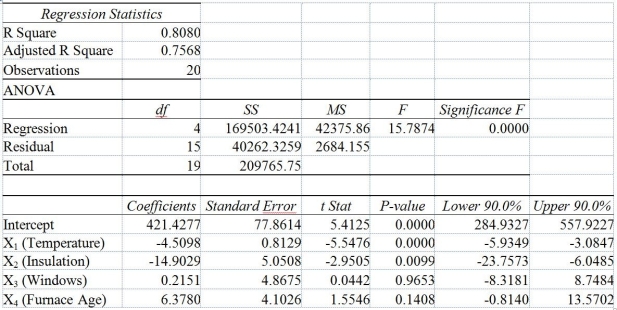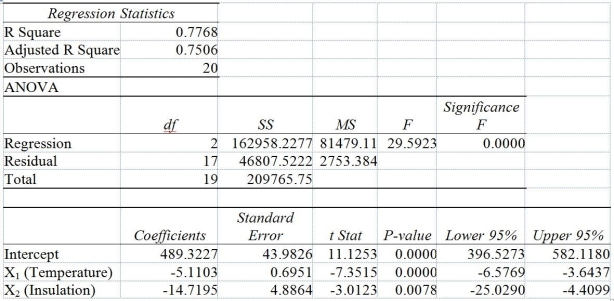Multiple Choice
TABLE 14-6
One of the most common questions of prospective house buyers pertains to the cost of heating in dollars (Y) . To provide its customers with information on that matter, a large real estate firm used the following 4 variables to predict heating costs: the daily minimum outside temperature in degrees of Fahrenheit (X₁) the amount of insulation in inches (X₂) , the number of windows in the house (X₃) , and the age of the furnace in years (X₄) . Given below are the Excel outputs of two regression models.
Model 1

Model 2

-Referring to Table 14-6 and allowing for a 1% probability of committing a type I error, what is the decision and conclusion for the test H₀: β₁ = β₂ = β₃ = β₄ = 0 vs. H₁: At least one βⱼ ≠ 0, j = 1,2,..., 4 using Model 1?
A) Do not reject H₀ and conclude that the 4 independent variables have significant individual linear effects on heating costs.
B) Reject H₀ and conclude that the 4 independent variables taken as a group have significant linear effects on heating costs.
C) Do not reject H₀ and conclude that the 4 independent variables taken as a group do not have significant linear effects on heating costs.
D) Reject H₀ and conclude that the 4 independent variables taken as a group do not have significant linear effects on heating costs.
Correct Answer:

Verified
Correct Answer:
Verified
Q35: When an explanatory variable is dropped from
Q136: TABLE 14-3<br>An economist is interested to see
Q137: TABLE 14-15<br>The superintendent of a school district
Q138: An interaction term in a multiple regression
Q139: TABLE 14-8<br>A financial analyst wanted to examine
Q140: TABLE 14-5<br>A microeconomist wants to determine how
Q143: TABLE 14-10<br>You worked as an intern at
Q144: TABLE 14-8<br>A financial analyst wanted to examine
Q145: TABLE 14-4<br>A real estate builder wishes to
Q146: TABLE 14-15<br>The superintendent of a school district